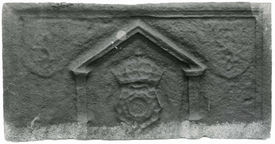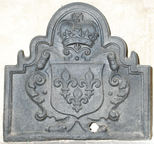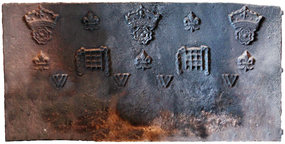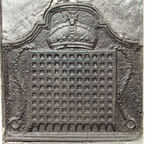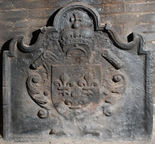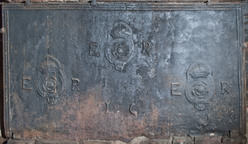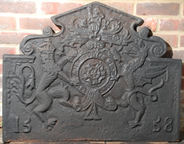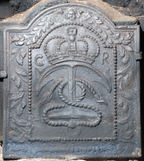-
1053
Description: Rectangular; cyma curve and fillet edging; crowned Tudor rose within a pediment resting on Tuscan pilasters and pedestals; faint impression of a shield bearing a lion rampant repeated in each top corner.
Notes: The width of this fireback may indicate that another fireback in this series was used as its pattern and the shields added before casting.
- Decoration tags:
- rectangular (shape)
- cyma curve and fillet (edging)
- carved stamps
- whole carved pattern
- heraldic
- architectural
- armorial
- royal
Manufactured: in the mid- to late-16th century in the Weald area of England.
Current location: Anne of Cleves House, Southover High Street, Lewes, East Sussex, England.
Museum number: LH000.954 (part of the Sussex Archaeological Society museum group)
- Attached to series:
- Miscellaneous royal firebacks
- Pedimented rose and crown series
-
488
Description: Rectangular with complex quasi-arched rectangular top; fillet edging; shield with Royal arms of France in a cartouche; above, an English crown.
Notes: The combination of the English crown and French arms is common and may relate to the marriage of Charles I and Princess Henrietta Maria of France in 1625. A different version is no. 659. Said to have been cast by Thomas Prickett (1727-95) at Gloucester Furnace, Lamberhurst. Formerly part of the J. H. Every collection.
Copies of this fireback are known.
Arms: France modern
- Decoration tags:
- rectangular with round arch (shape)
- fillet (edging)
- whole carved pattern
- armorial
- royal
Manufactured: in the early- to mid-17th century probably at Gloucester Furnace, Lamberhurst in the Weald area of England.
Current location: Michelham Priory, Arlington, East Sussex, England.
Museum number: 1944.24.068 (part of the Sussex Archaeological Society museum group)
Citation: Dawson, C., 1903, 'Sussex Iron Work and Pottery', Sussex Archaeological Collections, 46, pp. 1-54.
- Attached to series:
- Ornate border series
- Miscellaneous royal firebacks
- Anglo-French armorial firebacks
-
1222
Description: Rectangular shape; no edging; symmetrical arrangement of four stamps: across the top, three crowned roses with a fleur-de-lys between each pair; across the middle, three fleurs-de-lys with a chained portcullis between each pair; below and in the spaces between the fleurs and portcullises, four letters W.
Notes: The letter W may have an apotropaic significance; the stamps have not been recorded on other firebacks.
Inscription: W W W W
- Decoration tags:
- rectangular (shape)
- none (edging)
- carved stamps
- heraldic
- apotropaic
- text
- objects
Manufactured: in the late-16th century possibly in the Weald area of England.
Current location: Great Dixter, Northiam, East Sussex, England.
- Attached to series:
- Miscellaneous royal firebacks
-
592
Description: Flattened arched rectangular shape with rebated concave shoulders; double fillet edging; 11 x 9 grid portcullis with symmetrical chains in ‘S’ arrangement ending in a ring, from top corners, surmounted by an arched royal crown.
Notes: Whole pattern; the portcullis has a realistic, rather than symbolic, appearance.
Copies of this fireback are known.
- Decoration tags:
- rectangular with canted top corners and round arch (shape)
- stepped fillet (edging)
- whole carved pattern
- heraldic
- pictorial
- objects
Manufactured: in the late-16th to early-17th century in England.
Current location: Ham House, Richmond, Surrey, England.
Museum number: 1140112 (part of the National Trust museum group)
- Attached to series:
- Miscellaneous royal firebacks
-
833
Description: Rectangular; cavetto-moulded edging; armorial of France modern in front of a cartouche; above, an English royal crown between two small lion masks; two lion rampant supporters.
Notes: Believed to be associated with the marriage, in 1625, of Charles I with Princess Henrietta Maria of France, the juxtaposition of the arms of France with an English crown is seen on several firebacks, normally with a distinctive ornate edging; on this fireback is the unusual addition of two lion supporters, which are heraldically incorrect.
Arms: France modern
- Decoration tags:
- rectangular (shape)
- cavetto (edging)
- whole carved pattern
- armorial
Manufactured: in the early- to mid-17th century possibly in the Weald area of England.
Current location: Mark Ripley Forge & Fireplaces, Northbridge Street, Robertsbridge, East Sussex, England.
- Attached to series:
- Miscellaneous royal firebacks
- Anglo-French armorial firebacks
-
659
Description: Rectangular with complex quasi-arched rectangular top; ovolo moulded edging; shield with Royal arms of France in a cartouche; above, an English crown.
Notes: A different version of no. 488. The combination of the English crown and French arms is common and may relate to the marriage of Charles I and Princess Henrietta Maria of France in 1625; probably the work of the same pattern maker. Many copies exist of this fireback.
Copies of this fireback are known.
Arms: French royal
- Decoration tags:
- rectangular with round arch (shape)
- ovolo (edging)
- whole carved pattern
- armorial
- royal
Manufactured: in the early- to mid-17th century in the Weald area of England.
Current location: in private hands, Rolvenden, Kent, England.
- Attached to series:
- Ornate border series
- Miscellaneous royal firebacks
- Anglo-French armorial firebacks
-
1147
Description: Rectangular shape; triple fillet moulded edging (top and sides); overpressed stamp, repeated three times (top centre and below, to left and right) of a crowned rose within a circular garter, each with the initials ER to left and right respectively; lower centre, the initials IC.
Notes: The rose and crown stamp bears striking similarities to rose and crown designs used to mark some bronze cannon of the Tudor period. The initials ER could refer to Edward VI (1547-53) or Elizabeth I (1558-1603). The initials IC most probably relate to the person for whom the fireback was made.
Inscription: ER [thrice] / I C
- Decoration tags:
- rectangular (shape)
- triple fillet (edging)
- carved stamps
- individual letters
- heraldic
- royal
- text
Manufactured: in the mid- to late-16th century in the Weald area of England.
Current location: in private hands, Rolvenden, Kent, England.
- Attached to series:
- Miscellaneous royal firebacks
- Miscellaneous stamp firebacks
-
682
Description: Rectangular, with detached pediment joined by mirrored S-shaped scrolls; fillet edging with scalloping on inside edge (top and sides of rectangle, and pediment, only); central Tudor rose with surrounding garter, crowned lion and dragon supporters, surmounted by a helmet, mantling and crowned lion passant crest; initials, ER, separated by crest; initials, TP, in top corners of rectangle; ‘date’ split between bottom corners.
Notes: Stylistically of the late 16th or very early 17th centuries, the date is absent from some versions, and is likely to have been added spuriously to later recastings, of which this is one, the style of the numerals being identical to a series of firebacks cast in 1648-58.
Copies of this fireback are known.
Inscription: E R / T P / 1558
- Decoration tags:
- rectangular with detached pediment (shape)
- scalloped fillet (edging)
- whole carved pattern
- individual numbers
- heraldic
- royal
- text
Manufactured: in the mid-17th century possibly at Tintern Furnace in the Forest of Dean area of Wales.
Current location: in private hands, Sedlescombe, East Sussex, England.
- Attached to series:
- Miscellaneous royal firebacks
- 1640-50s Dean series
-
684
Description: Arched rectangular central panel with bead edging; an inverted, cabled anchor surmounted by a crown, flanked by one initial each side; arched rectangular border with cavetto-moulded edging; top centre, face of a putto with flowing leaf arrangement descending each side.
Notes: An English pastiche of the ‘Dutch’ style of fireback, which became popular in the second half of the seventeenth century. One of a small series of firebacks with similar proportions and detail. Much copied.
Copies of this fireback are known.
Inscription: C R
- Decoration tags:
- rectangular with round arch (shape)
- cavetto (edging)
- whole carved pattern
- planklines
- heraldic
- text
- objects
Manufactured: in the mid- to late-17th century in England.
Current location: in private hands, Sevenoaks, Kent, England.
- Attached to series:
- Carolean 'Dutch' series
- Miscellaneous royal firebacks
-
1087
Description: Arched rectangular shape; cavetto-moulded edging; central fouled anchor within a Garter surmounted by a ducal coronet; fructal swags to each side.
Notes: The anchor may relate to the office of Lord High Admiral who, in the third quarter of the 17th century was James, Duke of York (afterwards King James II). Another example was sold at Christie's auction 12 Oct 2010 lot 109 (£500). A variant with a viscount's coronet is at Chastleton House, Oxfordshire.
Copies of this fireback are known.
Inscription: HONI SOIT QUI MAL Y PENSE
- Decoration tags:
- rectangular with round arch (shape)
- cavetto (edging)
- whole carved pattern
- heraldic
- text
- objects
Manufactured: in the mid- to late-17th century in England.
Current location: Stratford upon Avon, Warwickshire, England.
- Attached to series:
- Miscellaneous royal firebacks
